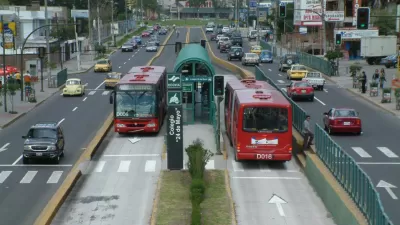A recent study by the World Resources Institute for Maryland's upcoming Purple Line project sided with BRT. WorldChanging asks researchers Greg Fuhs and Dario Hidalgo how they came to side with buses.
JL: Although your report shows that BRT will cost about half the amount of a light rail system, other studies show that light rail systems, because they are permanent structures, do more to encourage transit-oriented development. Was TOD a factor in the EMBARQ study? Do you think that BRT can facilitate and encourage dense development at a similar level?
GF: We did not look specifically at the TOD factor in our study. However, one cannot assume that transit-oriented development would be sparked by light rail but not BRT. For example, a recent study by the American Public Transportation Association looking at this issue considers both rail and traditional bus systems (although unfortunately it does not look at BRT specifically), and indicates that both can lead to significant positive land use changes. In any case, there is no reason to assume that LRT has a greater impact on land use than high-quality BRT if the systems provide similar travel times, capacities, and overall quality of service, as would be the case for the Purple Line. Moreover, developers can benefit from the shorter implementation time that BRT projects bring as compared to LRT.
DH: Also, regarding permanence, this is a somewhat relative concept. For example, there were thousands of miles of tram networks in the U.S. by 1940; much of this system was dismantled before 1970 with the rise of the automobile and suburbia. The forces behind development are not limited to the technology of transit vehicles, but also depend on factors such as accessibility, enabling policies, and background economics.
FULL STORY: Worldchanging Interview: WRI on Bus Rapid Transit v. Light Rail

Alabama: Trump Terminates Settlements for Black Communities Harmed By Raw Sewage
Trump deemed the landmark civil rights agreement “illegal DEI and environmental justice policy.”

Planetizen Federal Action Tracker
A weekly monitor of how Trump’s orders and actions are impacting planners and planning in America.

The 120 Year Old Tiny Home Villages That Sheltered San Francisco’s Earthquake Refugees
More than a century ago, San Francisco mobilized to house thousands of residents displaced by the 1906 earthquake. Could their strategy offer a model for the present?

In Both Crashes and Crime, Public Transportation is Far Safer than Driving
Contrary to popular assumptions, public transportation has far lower crash and crime rates than automobile travel. For safer communities, improve and encourage transit travel.

Report: Zoning Reforms Should Complement Nashville’s Ambitious Transit Plan
Without reform, restrictive zoning codes will limit the impact of the city’s planned transit expansion and could exclude some of the residents who depend on transit the most.

Judge Orders Release of Frozen IRA, IIJA Funding
The decision is a victory for environmental groups who charged that freezing funds for critical infrastructure and disaster response programs caused “real and irreparable harm” to communities.
Urban Design for Planners 1: Software Tools
This six-course series explores essential urban design concepts using open source software and equips planners with the tools they need to participate fully in the urban design process.
Planning for Universal Design
Learn the tools for implementing Universal Design in planning regulations.
Clanton & Associates, Inc.
Jessamine County Fiscal Court
Institute for Housing and Urban Development Studies (IHS)
City of Grandview
Harvard GSD Executive Education
Toledo-Lucas County Plan Commissions
Salt Lake City
NYU Wagner Graduate School of Public Service





























